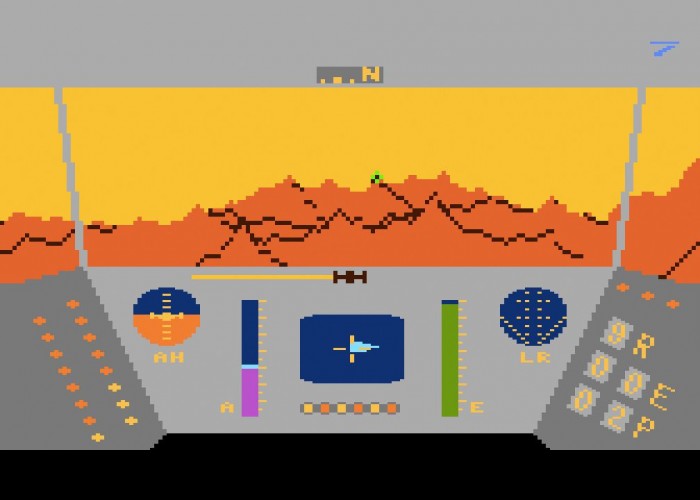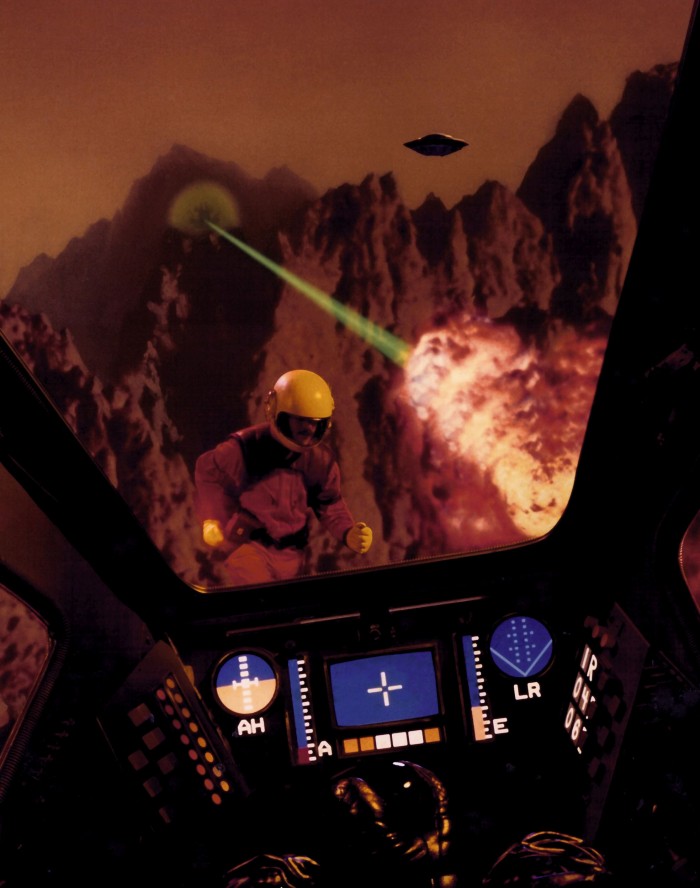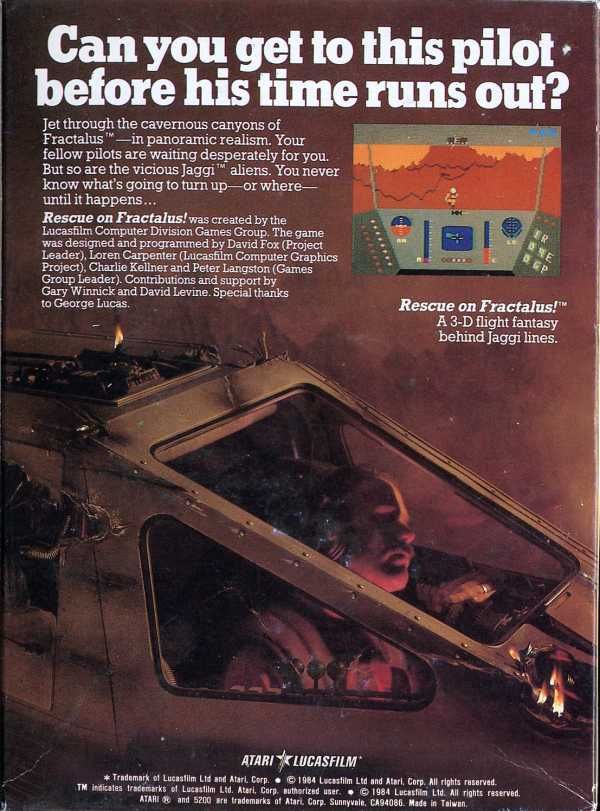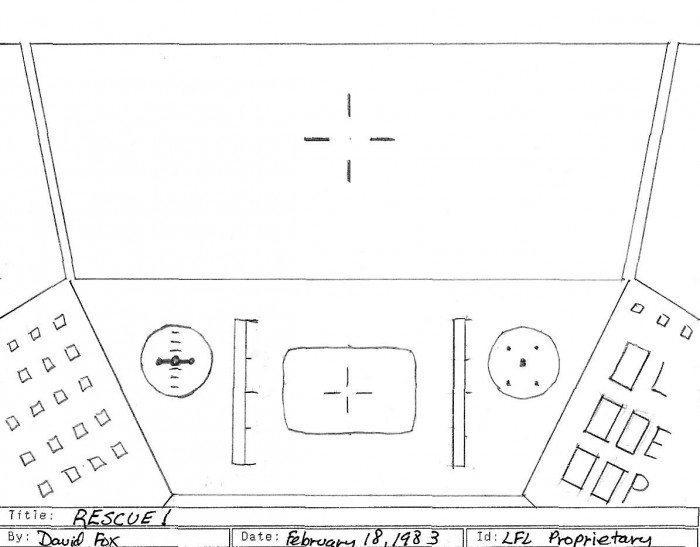How George Lucas Helped Create The First Video Game Jump Scare
The list of truly effective video game jump scares is a short but powerful one. The dogs bursting through the windows in Resident Evil. The woman with the broken neck in Fatal Frame. Freddy Fazbear in Five Nights at Freddy's. The aliens in Rescue on Fractalus! Wait...what's that last one?
Yes, it turns out that an 8-bit LucasArts game originally released for the Atari 800 contains what may be the first (and still most effective!) jump scare in video game history...and George Lucas is partially responsible.
A LucasArts Without Star Wars
Back when LucasArts was Lucasfilm Games, and even before it became beloved for its adventure games such as The Secret of Monkey Island, Indiana Jones and the Last Crusade, and Loom, they had the whole universe open to them. The early employees were allowed to work on any kind of game they wanted with one notable exception, and that was any Star Wars games. It seems unthinkable now, but Lucas had already sold the game rights to Parker Brothers and Atari and was making too much money from it to give it to his own team.
I was recently able to speak with David Fox, programmer of trendsetting games such as Zak McKracken and the Alien Mindbenders and Maniac Mansion, about working at the company in its early days. Fox was the third employee at Lucasfilm and joined it excited to get to work on a video game of their most famous franchise. He immediately started designing a first-person space simulator, drawing up a cockpit that mimicked the interior of an X-Wing, but it was not to be.
"I was disappointed, yeah," admits Fox. "I wanted it to be Star Wars. When I realized we couldn't do that, then it was ok, since we kept the game design the same, just not in the same universe any more."
Thus was born Rescue on Fractalus!
Behind Jaggi Lines, No One Can Hear You Scream
Rescue on Fractalus seems fairly innocuous at the beginning. You fly a spaceship called the Valkyrie ("Don't call it a V-Wing," the instruction booklet humorously notes) in the middle of a war against the Jaggies, an alien race whose name is a nice nod to the game's jagged, aliased graphics. The war has claimed many fellow pilots and it's your mission to venture to alien planets and rescue any survivors. After landing near a pilot, you have to turn off the ship's shields and open up the airlock for them to board and be whisked away to safety. This is an easy task at first, as you shoot down enemy saucers and gun emplacements and collect a number of stranded people, but then there's a pretty big twist – once in a while, the pilot is an alien in disguise attempting to get in your ship and murder you.
See, if you don't open the airlock right away the pilot will knock on the door. The banging sound is unsetting in the void of space, but also reassuring, as only humans knock. Jaggies rear up in front of the windshield with a synthetic screech and pound at it with their fists, smashing through and killing you if you don't get the shields up in time to fry it.
It's utterly terrifying for a first-time player, and Fox did this all by design.
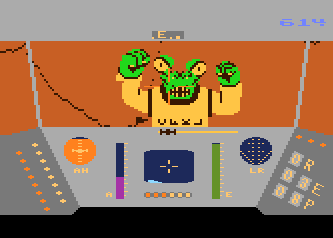
"If you're playing a horror game then you're probably bracing yourself at all times," says Fox. "But a true jump scare has to be during a time where nothing's being telegraphed, you're not expecting it and it happens."
But it turns out that the whole concept for the alien attack came from none other than George Lucas.
"We were showing [Lucas] the game for the first time and he had some feedback. One of the things was that we had to add some suspense by making one of those pilots you pick up not be a pilot, make it something else like an alien. So we had the aliens already in terms of the story and we decided to figure out a way that we could pull it off within the constraints of the memory and everything else."
This led to the creation of this monstrosity by Gary Winnick, who was hired on as an artist and animator on LucasFilm Games' first titles before moving on to design titles like Maniac Mansion.
It may not seem like much in this age of bloody, mind-bending titles (and VR experiences), but the very nature of its surprise left impressionable minds with life-long scars. I can attest to this because I am one of them. I played the game as a child on my aunt's Commodore 64, which was conveniently located in her basement, a dark and cold place that, from that point forward, I was always afraid to visit.
Fox had no idea of the impact of his work until years later, when people found his email address and started sending him stories about falling off of their chairs in horror and waking up their loved ones with shrieks.
"I knew it was powerful but I didn't know how much it would traumatize people or stick with them," says Fox. "People would remember the first time it happened. A women who we were working with said her five-year-old kid came out screaming 'Mommy there's a monster in my computer!'"
The Sounds of Jaggies
As everyone knows, horror games are nothing without incredible sound design. Titles like Amnesia: The Dark Descent or Dead Space would never have been effective if it weren't for the crippling atmosphere. Thankfully Fox knew this:
"We had this THX theater that was already part of Lucas. We already knew how important sound design was so we had great sound designers. Peter Langston, who was our general manager, was also a great musician and he had a Yamaha synthesizer keyboard in his office and he was able to come up with some cool sound effects. I told him what I was looking for the chord that plays when the Jaggi pops up. Without that the Jaggi pop-up is nowhere as effective, kind of a horror show stinger."
Charlie Kellner also managed to create multi-channel audio that made it seem as if they were playing way more sounds than they actually were, a virtual 16-track that allowed lower sounds to drop out and be superseded by louder ones before coming back. He added sounds like an engine drone and whine that made you feel more immersed in the ship...and the silence before a pilot appears that much more tense.
Another Connection to the Stars
When Fox started at LucasArts, it was so early that they didn't even have an area set up for the team yet. He ended up sharing office space for three months with Loren Carpenter, the legendary computer graphics researcher. Carpenter may be best known for creating the "Project Genesis" landscape sequence for Star Trek II: The Wrath of Khan, generally known as the very first 3D CGI ever made for film.
The key behind his effects were fractals, geometric figures that allowed them to recreate a mountainous alien landscape:
"I had actually met him a year and a half earlier when I was working on a book on computer animation and knew him as a fractal person from then. He'd done this video called Vol Libre while he was still working for Boeing and that's what got him the job at Lucas. So I asked him when I started working there – 'Do you think it's possible to do fractals on an 8-bit computer like the Atari?' And he kinda laughed at me and went "No, no, course not." And then he was thinking for a second and he said "'Well... maybe.'"
The team loaned Carpenter an Atari 800 and in a mere three days, he taught himself how to code 6502 Assembly language and made a working demo. When he came back, he showed it to a stunned Fox, who saw that he had a playable demo of flying through a procedurally generated fractal landscape that was running at 8-10 frames per second. That may not seem like much today, when everyone is aiming for silky smooth 60 FPS, but as Fox points out, this was 1982, where flight simulators at the time were running three or four frames per second. "It was impressive and it also was randomly generated so I go okay, I think we have a game!"
Newsflash: Lucas Loves Lasers
As Fox envisioned the game, it wasn't about fighting. "I was an ex-hippie peacenik guy and I didn't want to do a shoot'em up," says Fox. "I wanted to make it a pure rescue mission."
The enemy saucers and gun emplacements that try to shoot you down were always in the game, but your ship wasn't equipped with lasers to fight back. There was still skill involved, as flying erratically could help you avoid getting locked on by the gun emplacements. This works in the final game, but in the original design, the only way to get away from saucers was to make them crash:
"The idea was going to be if you fly towards a mountain and make a hard turn, they wouldn't be as quick as you are and would end up flying into it and crashing, all of this using a rear-view mirror. It was always supposed to be a defensive game."
During a meeting with George Lucas, however, that all changed:
"The first thing Lucas tried was pushing the red joystick button and he said 'Where's the fire button? Why doesn't this do anything?' I told him why and he asked if that was for gameplay purposes, or was it a philosophical purpose? I started hemming and hawing and he understood that it was more philosophical than game design. So he said 'Put in a fire button.'"
Thus, lasers.
ILM
Another benefit of working at Lucasfilm was access to Industrial Lights and Magic (ILM), who created models for the game's box art. At the time, Fox says Atari was paying around $25,000 for the manual and box art, something that seems unthinkable in a world where you are now lucky to get an insert of any kind and if you can actually find a physical copy of a game. This money allowed them to commission ILM for incredibly detailed models representing the ships from the game, including the Valkyrie ship and Jaggi saucer:
'The [saucer] model was maybe fourteen inches across and the guy who did it had spent the last six or seven years working on the three Star Wars movies, and he was just excited to be doing something that was saucer-shaped. So he put all his energy into it and made it tremendously detailed, way more than the photo shoot called for."
On top of that, they also built a full-scale Valkyrie cockpit, which Fox himself sat in for the shoot:
"I sat inside the cockpit and they had me in a flight suit. The helmet was a motorcycle helmet that was sprayed kind of a cream color and for the earpieces they put model tank turrets so it looks like a antenna coming off the top. I actually have that still."
They told Fox not to shave for the shoot, since they used a picture of him looking out of the cockpit on the back of some boxes. They even made sure his wedding ring was showing in the picture in order to give the impression that this poor guy was stranded on another world while his wife was at home, waiting for him.
The Never-ending Story
One interesting thing I learned during our discussion was that the game doesn't have an ending.
"We didn't have space!" says Fox. "We didn't know what the win would be and we didn't have the space on a 16k cartridge so we figured okay, we'll just make it harder and harder till it's impossible." Theoretically there's 99 levels because that's how much code was written, but he doesn't know of anyone who's made it that far, and he could only get to 30 or 40 himself.
Fox had envisioned a game with more variety, including new planets to explore with different types of environments, more weapons, and new types of challenges. Every four to eight levels, there would be a twist to the formula, some additional change to the gameplay. One of the only twists they had was a day/night cycle, which led you to flying some missions utterly in the dark, and the Ace pilot, who shows up wearing a different helmet and offers more points. He was easy to program since he used the same code as the regular pilots.
But at the time, no one seemed to notice it was unbeatable. Perhaps players just assumed that they could make it to the end if they just got a little better at the game.
The Future
One of the saddest things is that Rescue on Fractalus! has been lost to time. Since the game never got ported to PC, it also never got included with any of the numerous LucasArts compilations that gamers were gifted with during the CD-Rom revolution. When smartphones exploded onto the scene, Fox sought a way to bring it back:
"I actually tried to do a deal with LucasArts maybe eight years ago where we wanted to do a mobile version of the game. We got pretty far and had great discussions with the team at LucasArts. At the time they were all doing remakes of some of the Monkey Island games, so the idea of bringing out some of the golden oldies and revamping them was already something they were doing. Then the president of LucasArts, who was a huge fan of the old games, got laid off, and they had a big shakeup. And then it was 'We don't want to do old games, just the Star Wars games. Just new stuff' And the deal got killed."
They never got to the point of contracts, so Fractalus! still lies marooned behind enemy lines. Perhaps, one day, we will return to the stars to fight the Jaggi menace once more but for now, Rescue on Fractalus! lives on only in scars from childhood memories.
***
David Fox has returned to his roots by programming Thimbleweed Park alongside Maniac Mansion designers Ron Gilbert and Gary Winnick. The throwback point and click adventure game was released yesterday. You can learn more about Fox's work at Electric Eggplant http://electriceggplant.com and follow him on Twitter @DavidBFox.

